EU4OceanObs is developing case studies on the Earth Observation (EO) value chain on ocean and coastal related themes. From satellite and in situ observation, to monitoring and forecasting services, to data access and cloud services, to marine and coastal derived applications and services. The case studies will highlight the European Union’s contribution along the value chain, providing concrete examples of pan-European and European led initiatives, projects and services to address challenges and problems related to each theme.
Each case study will explore good practices to raise awareness for the essential role of ocean and coastal observations in responding to associated societal challenges. Identifying gaps in observation, monitoring and forecasting, and data access, the case studies also put forward recommendations to address these gaps.
The themes selected are aligned with priority areas of EU4OceanObs, fed by the activities of the European coordination of GEO Blue Planet (e.g. Sargassum, marine litter, fisheries, eutrophication) and G7 Future of the Seas and Oceans Initiative (FSOI) (e.g. ocean carbon, marine biodiversity, sea ice).
Target audiences
The Earth observation value chain case studies target decision-makers and local authorities confronted with related issues and themes, blue economy industries, and researchers looking to collaborate and explore existing services, infrastructures and programmes.
Click on icon below to access PDF version of each use case.
Raising awareness on the ocean observing value chain for societal benefit through thematic use cases
Earth observation for monitoring and forecasting Sargassum in the tropical Atlantic
Use cases from European programmes and projects
EU4OceanObs also works to showcase and promote existing use cases in the different components of the ocean observing value chain developed by European funded services, programmes, and projects, including:



